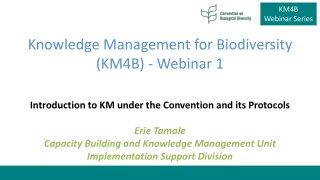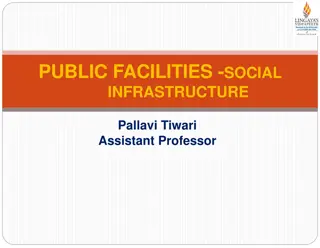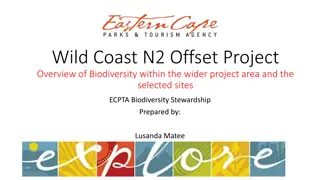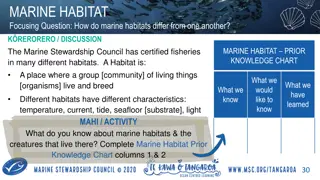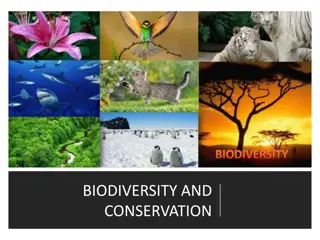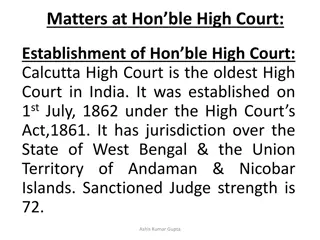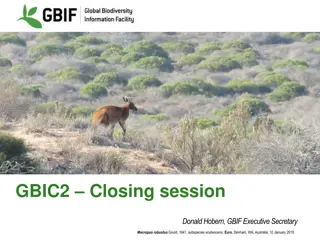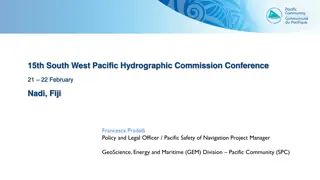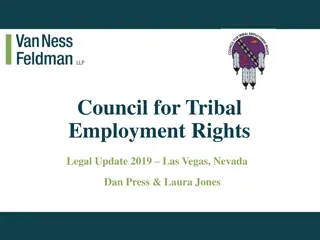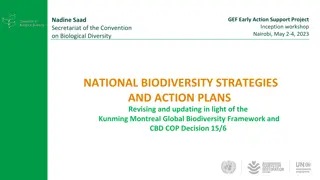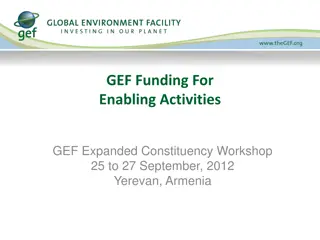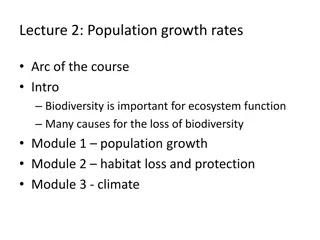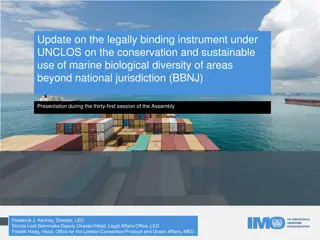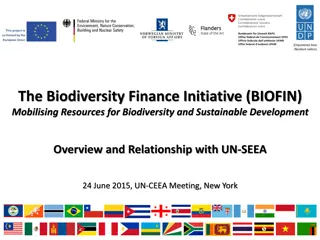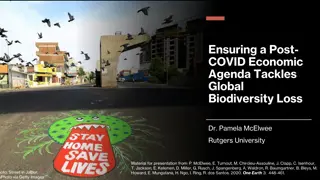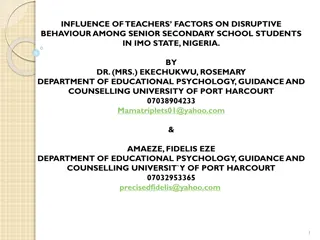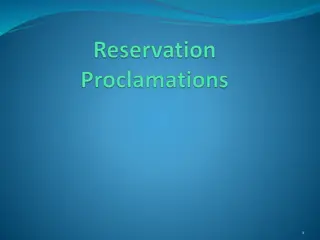Update on UN Conference on Marine Biodiversity of Areas Beyond National Jurisdiction (BBNJ) Information Session for IMO Member States
In 2015, the UN General Assembly decided to develop a legally binding instrument on BBNJ for conservation and sustainable use of marine biological diversity in areas beyond national jurisdiction. The objectives focus on marine genetic resources, area-based management tools, environmental impact assessments, capacity-building, and technology transfer, along with cross-cutting issues like institutional arrangements and international cooperation. Intergovernmental conferences have taken place, with significant progress made in addressing key topics across various sessions.
Download Presentation

Please find below an Image/Link to download the presentation.
The content on the website is provided AS IS for your information and personal use only. It may not be sold, licensed, or shared on other websites without obtaining consent from the author.If you encounter any issues during the download, it is possible that the publisher has removed the file from their server.
You are allowed to download the files provided on this website for personal or commercial use, subject to the condition that they are used lawfully. All files are the property of their respective owners.
The content on the website is provided AS IS for your information and personal use only. It may not be sold, licensed, or shared on other websites without obtaining consent from the author.
E N D
Presentation Transcript
Update on the UN conference on marine biodiversity of areas beyond national jurisdiction (BBNJ) Information session for IMO Member States, 21 June 2019 Dorota Lost-Sieminska Deputy Director/Head, Legal Affairs Office, LED Fredrik Haag, Head, Office for the London Convention/Protocol and Ocean Affairs, MED
Background 2015: UNGA decides to develop an international legally binding instrument on BBNJ, following almost a decade of discussions Objective: Conservation and sustainable use of marine biological diversity of areas beyond national jurisdiction Focusing on five main areas: Marine genetic resources (MGR); Area-Based Management Tools (ABMT); Environmental impact assessments (EIA); Capacity-building and the transfer of marine technology (CB&TT); Cross-cutting issues: institutional arrangements, the clearinghouse mechanism, general elements, principles and approaches and international cooperation 2
Background, continued In 2017, the General Assembly decided to convene an intergovernmental conference (IGC), to develop the instrument The Secretariat has participated throughout the preparatory phase leading up to this conference (since 2008) 2016-2017: Preparatory Committee (four sessions). Secretariat attended, providing written input, statements and organized side-events (jointly with Member States and ICS) to inform of IMO s work 3
Background, continued The first IGC session took place in New York from 4 to 17 September 2018, and the second from 25 March to 5 April 2019 The third IGC session will take place from 19 to 20 August 2019, and the fourth session in the first half of 2020 All UN Member States are represented at the Conference and the negotiations are undertaken between the representatives of those States Groups of States (such as Group of 77, African Group, SIDS) play a big role in the negotiations IMO, same as other organizations, like FAO, IOC, ISA, have an observer status at the Conference 4
Summary of the first two sessions of the IGC Addressed and made progress on the main topics: Marine genetic resources (MGR); Area-Based Management Tools (ABMT); Environmental impact assessments (EIA); Capacity-building and the transfer of marine technology (CB&TT); Cross-cutting issues: institutional arrangements, the clearinghouse mechanism, general elements, principles and approaches and international cooperation Agreed that the new instrument should: be fully consistent with UNCLOS; not undermine existing relevant legal instruments and frameworks and relevant global, regional and sectoral bodies, such as IMO 5
Area Based Management Tools under the BBNJ instrument Area Based Management Tools (ABMTs) relate to the establishment of e.g. marine protected areas (MPAs) May affect areas established by IMO such as PSSAs, Special Areas, routing measures, etc. It is important to ensure that measures adopted by BBNJ will not conflict or interfere with measures adopted by IMO, as well as internationally established legal framework on navigation rights 6
Area Based Management Tools, continued IMO has several ABMTs at its disposal, which are already in existence and effectively regulating international shipping: Special Areas and Emission Control Areas, under MARPOL; Particularly Sensitive Sea Areas (PSSAs), which can in principle incorporate any IMO measure that it has at its disposal to protect the marine environment; and Ships routeing measures, to ensure safety of navigation and protection of the marine environment 7
Relevance of the BBNJ instrument for IMO ABMT cont. Through IMO (based on the framework and responsibilities set out in UNCLOS) Member Governments have established a comprehensive regime for international shipping, ensuring safety of navigation and protecting the marine environment, which includes several options for area based management tools, all firmly based in globally binding IMO instruments IMO opposes that ABMTs which fall under IMO s mandate will be designated by another decision-making body IMO advocates for no duplication of existing measures The BBNJ instrument will also regulate cooperation and coordination mechanism between global and sectoral organizations 8
Environmental Impact Assessments EIAs are not explicitly referenced in IMO s regulatory framework in a formal sense. However, the process of evaluating the impacts of activities regulated by IMO are embedded in several ways The Waste assessment framework under the London Convention and London Protocol: Sets out procedures for assessing impacts of any proposed activities for dumping at sea Includes a waste prevention audit, consideration of options, a characterisation of the properties, site selection, assessment of effects, monitoring and permitting An example of an assessment procedure that is already applied in all waters, through the application of Flag, Port and Coastal State responsibilities (see LP article 9.2) 9
Environmental Impact Assessments, continued Formal Safety Assessments (FSA): FSA s require consideration of potential environmental damage, clean-up costs, cost/benefit with respect to the environment See MSC-MEPC.2/Circ.12/Rev.2) 10
Environmental Impact Assessments, continued Discussions at the IGC includes a variety of options for possible EIAs under the new BBNJ treaty Possible list of activities which do not require EIA shipping (?) Any new tools developed under the instrument should be complimentary in nature to the existing IMO tools, standards and guidelines, and work in tandem with the existing IMO regime 11
Environmental Impact Assessments, continued IMO opposes the direct application of the BBNJ instrument on EIAs under IMO s framework If new global standards and guidelines are to be developed IMO needs to participate to avoid duplication IMO supports that the Organization should be included in public notification and consultation processes regarding EIA Ensure that the outcomes do not to disrupt the existing legal framework, and in particular the principles of freedom of the high seas and navigation rights, including innocent passage and transit passage 12
Capacity building and the transfer of marine technology States, directly or through competent international organizations, shall promote cooperation in CB&TMT to assist developing countries in achieving the objectives of the instrument Promoting technical cooperation constitutes a major part of the IMO s work, thus IMO should be recognized as one of the competent organizations 13
Relevance of the BBNJ instrument for IMO capacity building The BBNJ instrument may contain a list of needs and activities (currently 40 activities listed) The list will be updated in response to evolving needs of States and regions Possible ad hoc working groups/subsidiary bodies to develop the list 14
CB&TMT modalities Modalities: reference to IOC UNESCO Criteria and Guidelines on Transfer of Marine Technology Create new modalities Decision to be taken: mandatory or voluntary nature of transfer of marine technology 15
CT&TMT - funding Funding mechanism mandatory or voluntary (?) Besides existing sources, also: Operational fund Endowment fund Rehabilitation/liability fund 16
General principles and approaches Environmental principles and approaches: Precautionary approach Ecosystem approach Conservation and sustainable use of BBNJ Promoting participation and cooperation Special consideration of developing States Common heritage of mankind Freedom of high seas 17
General principles and approaches cont. Principles applied to MGR: the freedom of high seas shall govern the provisions for access to MGRs while the common heritage of mankind shall govern their exploitation Principles applied to ABMT: necessity; proportionality and balance between conservation and sustainable use the use of ABMT can not be excessive and hamper legitimate utilization of BBNJ 18
General principles and approaches cont. Principles applied to EIAs: Due diligence (States shall take reasonably appropriate actions to ensure that EIAs conform to the requirements of the new instrument); Universal participation (States are required to provide every stake holder with an opportunity to participate in EIA process) Principles applied to CB&TMT Needs of different categories of developing States should be taken into consideration 19
Institutional arrangements - secretariat BBNJ secretariat: o New independent secretariat o DOALOS o IOC/UNESCO o ISA The secretariat shall manage the clearing-house mechanism and coordinate consultation with relevant organizations on ABMTs 20
Institutional arrangements decision making body BBNJ decision making body: COP/Council/Assembly Assembly: all States Parties Council: elected States Parties Scientific/technical body (GESAMP) Other subsidiary bodies Decision making body will be responsible for cooperation and coordination with relevant global, regional and sectoral bodies such as IMO 21
Treaty law Currently: diplomatic conference Draft treaty to be presented in August 2019 The new instrument will be adopted under UNCLOS Open to all States General elements: definitions, principles Final clauses: depositary, entry into force still to be decided Relevant global, regional and sectoral bodies will be responsible for the implementation and enforcement where appropriate 22
IMO Secretariat approach to the IGC Throughout the PrepCom and the IGC, the IMO Secretariat has contributed to and organized several side events, providing input on IMO's work Side events organized together with several IMO Member States, ICS and Norwegian Shipowners Association IMO Secretariat works closely with United Nations and other specialized agencies (e.g. the FAO, ISA, UNEP, IOC of UNESCO and ILO) to coordinate the position and to ensure that the new instrument will not impact or impede the roles and responsibilities of other relevant global, regional and sectoral organizations. 23
Next steps The next session (IGC-3) will be held from 19 to 30 August 2019 Will consider a first full draft text of the future treaty (to be made available in July) The Secretariat will continue to follow the process and participate in the meetings, and will inform IMO Member States of the developments on a regular basis (MSC, MEPC, Council) 24
Next steps, continued Need to ensure that any procedures established under the BBNJ instrument are not inflicting on the IMO mandate, its instruments and processes, including any potential disruptions to the existing legal framework (in particular the principles of freedom of the high seas and navigation rights, including innocent passage and transit passage) Need for the IMO Member States to liaise with their delegations to IGC to ensure that the positions they present at the Conference are in line with their interests at IMO 25
Thank you for listening www.imo.org www.imo.org


